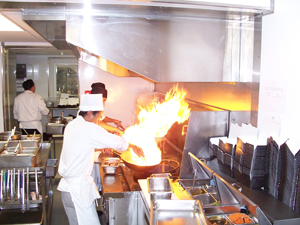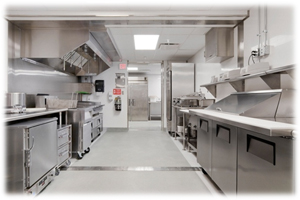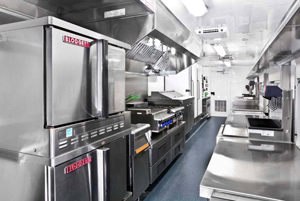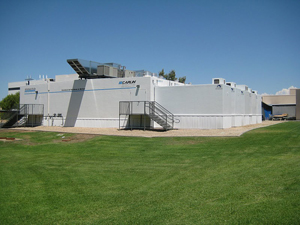“To phase or not to phase” is a renovation consideration that is becoming more and more common every day. As an operator, it is important to be aware of the solutions available when 1.) An existing production kitchen needs to be replaced or renovated and 2.) The customer base needs to be served during the renovation.
 The emotional impact of an extended construction project can impact your staff in negative ways.
The emotional impact of an extended construction project can impact your staff in negative ways.
What are the most common strategies?
- Phased Construction: Probably the most commonly used. A phased construction breaks a project into stages to try to minimize the impact of a renovation project on ongoing operations.
- Outside Catering: This strategy outsources the production of meals to an off-premises third party kitchen.
- Shutting Down: Probably the simplest option, an operation can simply shut down until renovations are complete.
- Temporary Kitchen Facilities: Establishing a temporary kitchen space outside of the renovation area allows both construction and operations to continue uninterrupted.
 A phased approach can cause unnecessary difficulties that can be addressed and avoided early in the planning process.
A phased approach can cause unnecessary difficulties that can be addressed and avoided early in the planning process.
Phased Construction
So, what’s so bad about phasing? Well, in some cases, nothing. If phasing is the most non-invasive and cost-effective option, then of course phasing the construction is a good choice. Unfortunately, phasing construction during a renovation comes with several indirect effects and hidden costs that that may not become apparent until it’s too late. Before choosing to phase a program, consider the following:
- Phased construction can push completion up to two to three times longer than it would take without phasing.
- By having a General Contractor and associated trades on site for an extended period, direct “General Conditions” costs increase.
- With a longer timeline, safety and health barrier segregation costs increase.
- “Construction fatigue” increases when everyone has to live in a construction zone environment for too long.
- Most importantly, a phased approach causes the ongoing disruption of the daily routine. This is a direct cause of inefficiency, which results in lost productivity, performance and increased labor costs.
Shutting Down
Completely shutting down operations during a renovation project is an option for most industries outside of healthcare or correctional. For a retail operation, however, several factors come into play which support keeping operations open, such as lost income, lost customer base and the risk of losing good team members or having to pay staff during the closure.
Outside Catering
In some scenarios, outside catering can be a cost-effective option, especially if the duration of the kitchen closure is short (e.g., during the replacement of a kitchen floor). However, using outside catering for a long-term kitchen closure might not be viable for the following reasons:
- Cost: Outside catering can cost 20% to 30% more per meal over the cost of in-house production, resulting in lost revenue.
- Staffing: Substantial reductions in staffing would be required during the kitchen closure, with no guarantee of availability to rehire at the completion of the renovation.
- Quality: Even with the latest technology available today for food transport, bringing meals in from an extended distance will directly affect the quality of the product being served to the customer. In addition, certain dietary requirements (especially in healthcare facilities) cannot be met with outside catering.
- Safety: Food handling is the number one greatest risk facing the foodservice industry today. The ability to maintain quality control with an outside food source is not equal to the control that operators can maintain within their own operation. This puts the foodservice operator and facility at increased risk.
- Flexibility: With the demand for higher levels of quality and variety in today’s competitive foodservice environment, the ability to maintain a flexible menu is a must (especially in healthcare foodservice, as so many facilities are transitioning to a room service approach).
 College and Universities can use a temporary kitchen to keep their students fed during a renovation.
College and Universities can use a temporary kitchen to keep their students fed during a renovation.
 With temporary kitchen facilities virtually in the same location, a renovation can speed through with minimal impact on operations.
With temporary kitchen facilities virtually in the same location, a renovation can speed through with minimal impact on operations.
Temporary Kitchens
Establishing an onsite temporary kitchen eliminates a lot of the drawbacks of both phasing and outside catering; it provides the operator with full control over the consistency and quality of meals while minimizing the time spent out of the facility.
In years past, the primary drawbacks to building a temporary kitchen were cost-effectiveness and available space. Some still believe that temporary kitchens are too expensive or unaffordable when an existing kitchen facility needs to be replaced or remodeled.
However, with innovations happening within the foodservice equipment industry, these concerns are quickly becoming negligible. Today, a temporary kitchen facility can provide a flexible solution for nearly any situation, and upon closer examination of the direct costs and the indirect effects of phased construction or outside catering, it may prove to be the most sensible and practical solution.
See how food service providers have partnered with Kitchens to Go to keep their operations running smoothly during renovations:
kitchenstogo.com/video/our-company-overview/



